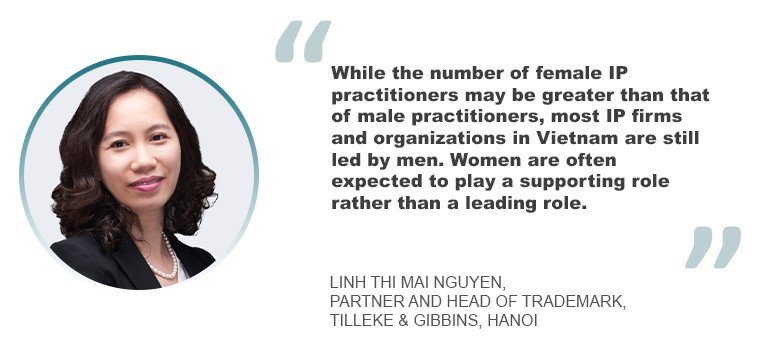Analyzing the gender gap and diversity in IP
31 March 2024

Despite advancements in female representation, gender disparities remain persistent in many fields. Excel V. Dyquiangco explores this persistent issue across various countries, including efforts needed to address systemic issues and ensure equal opportunities for women in the legal profession.
From the printing press to the internet, the world thrives on the ingenuity of its inventors and creators. Men and women across cultures and backgrounds have used their imaginations to shape lives for the next millennia. Yet, despite this shared journey of innovation, a concerning reality persists – underrepresentation and inequity in the intellectual property landscape.
According to data from the World Intellectual Property Organization (WIPO), although the ratio of female inventors in foreign patent applications slightly increased, from 15.5 percent in 2020 to 16.5 percent in 2021, only one-third of patent applications mention at least one female inventor. This percentage increased by 2 percent from the year before, as evidenced in some jurisdictions.
In Vietnam, the gender gap is considered less extreme than it is in some other countries. According to Linh Thi Mai Nguyen, a partner and head of trademarks at Tilleke & Gibbins in Hanoi, female workers account for a significant portion of the workforce in almost every sector. “So, generally, females play an important role in all industries, including IP law,” she said. “Nevertheless, in Vietnam, a gender gap still exists, and female practitioners may face certain challenges in advancing their careers.”
She said that among the most common indicators of the gender gap are business development and networking difficulties, work-life balance issues and underrepresentation in leadership roles.
“IP law is a field where networking is a key to expanding business. As such, for the purpose of career development, networking capability is a must for an IP practitioner. However, women may face more challenges in accessing the same networking opportunities as men,” she said. “Generally, Vietnamese society often views that women should not socialize too much or be the ones who initiate conversation. With that perception in mind, female IP practitioners are often more shy and reserved than their male colleagues, and hence somewhat limit themselves in networking activities.”
Work-life balance has always been an issue for both male and female practitioners, but it can be more challenging for women due to societal expectations and pressures stemming from traditional gender roles. Thus, balancing demanding workloads with family responsibilities can be a “headache” for female practitioners, Nguyen noted.

“While the number of female IP practitioners may be greater than that of male practitioners, most IP firms and organizations in Vietnam are still led by men. Women are often expected to play a supporting role rather than a leading role. As such, when it comes to promotion, a male candidate will usually be the first option. If there are two equally good candidates for a leadership role, the female candidate may be at a slight disadvantage. The underrepresentation in leadership roles can limit female practitioners’ opportunities for career advancement and decision-making roles, especially in personnel decisions,” she said.
In STEM and other sectors
In a study conducted in March 2023 in Malaysia, there seemed to be a gender difference in terms of employment relating to science, technology, engineering and mathematics (STEM), whereby 72 percent of employed men graduate compared to 69 percent of employed women. This trend may also correlate with patent and IP filings in general, owing to the technical nature of IP laws.
“While this may be the case, a perusal of the ratio between male partners and female partners in top law firms practising intellectual property law in Malaysia seems to suggest the gender gap in intellectual property law in Malaysia is not as apparent,” said Jyeshta Mahendran, a partner at Shearn Delamore & Co in Kuala Lumpur. “For example, a survey conducted in 2014 by the Association of Women Lawyers (AWL) in collaboration with the Human Rights Commission, Malaysia (SUHAKAM) and Women’s Aid Organization (WAO) reported almost equally as many male and female lawyers choosing intellectual property law as their primary area of practice. A more recent report in 2022 by Legal Media 360 on Gender Diversity at Malaysia Law Firms found 55 percent of female-ranked lawyers compared to 45 percent of male-ranked lawyers in the intellectual property practice area in Malaysia.”
The data also revealed that women outnumber men, wherein the number of lawyers in Malaysia in 2023 made up of 56 percent female lawyers compared to 44 percent of male lawyers.

“Women confront similar challenges regardless of their field of practice and job scope,” added Mahendran. “The recurring difficulty is balancing work and family commitments, particularly for women who can be disproportionately responsible as primary caregivers, resulting in them having to take a step back in their careers during the infancy stages of starting a family. Sexual harassment at workplaces, gender bias, discrimination and stereotyping of the potential of women in certain industries can also be an inhibiting factor in the advancement of a woman’s professional career. The AWL 2014 survey found that childcare duties involving young children below seven years old often pose an adverse impact on female lawyers’ careers.”
Because of these challenges, Malaysia plunged forward with some notable initiatives promoting gender diversity, including the 2022 revision to the Employment Act. In this, the length of maternity leave has increased from 60 to 98 consecutive days. Additionally, male employees are now entitled to seven consecutive days of paid paternity leave.
In addition, the changes in work culture post-pandemic, including the flexibility of remote working for certain practice areas, have allowed female practitioners to manage their work hours better while balancing childcare duties at home. More and more organizations in Malaysia are now increasingly devoted to environmental, social and governance (ESG) programs, which have influenced the workspace diversity landscape to some extent.
In the past, Malaysia also made strides towards better equality, such as the 2021 revision to the Malaysian Code on Corporate Governance, which promotes women’s participation in board positions and senior management, and the charter introduced by the Sabah Law Society, which includes provisions for women’s advancement in the legal profession.
An everyday behaviour project
The same is true in Hong Kong and Singapore. Gender diversity in the legal industry has improved, especially at the junior level. For example, the gender ratio for female entry-level trainee solicitors reached 65 percent in 2021, with a similar ratio mirrored for qualified solicitors. In Singapore, the gender ratio for qualified female lawyers in 2023 sits at 44 percent.
According to data from the Everyday Behaviour Project Report, the gender gap in the field of intellectual property law manifests itself quite similarly to other practice areas in the legal field. Women suffer from unconscious bias, such as being overlooked or discredited in meetings based on gender, and are often on the receiving end of unwanted comments and behaviour or other microaggressions.

Amita Haylock, a partner at Mayer Brown in Hong Kong and Singapore, said that the intellectual property law space is not immune to the systemic issues that plague the legal industry. “For example, women generally still shoulder greater caregiver responsibilities than men, which has demonstrably proven to be a hurdle (whether perceived or actual) to career advancement. Twice as many women as men say that they are not able to progress in their careers either because of the male-dominated environment in which they work or because family or care commitments lead to them being overlooked for advancement. This, amongst other factors, either discourages or actively prevents women from staying in the field, which in turn contributes to the ‘leaky pipeline’ issue.”
She added: “Further, legal practice is not insulated from and independent of the field to which it relates. Women are grossly underrepresented in the intellectual property field, with only 16 percent of international patent applications through the PCT system and 13.2 percent on the EPO system coming from women as of 2023. Over in the corresponding legal space, a 2020 analysis also found that only 28 percent of patent practitioners in Asia-Pacific are women.”
The Everyday Behaviour Project, a collaboration between Mayer Brown and Women in Law Hong Kong, is a first-of-its-kind research survey aimed at uncovering the range of behaviours that women in the Hong Kong legal sector deal with daily, including gender biases and microaggressions. Singapore has also recently made some headway in exploring the issue of gender diversity in the legal profession. In 2020, the Law Society of Singapore released a report, “Levelling the Playing Field: Report on Gender Diversity in the Singapore Legal Profession,” which highlighted some of the main concerns and biases female practitioners face, along with some recommendations (formal mentoring programs, sponsorship programs, alternative work arrangements and compulsory training on unconscious bias, amongst others).
Haylock said: “More needs to be done to address existing disparities, but these initiatives are a good first step in uncovering, measuring and discussing the very real challenges women face in the workplace and how gender diversity and inclusion can be meaningfully promoted. By taking the recommendations of these initiatives on board, I hope to see improvement in these areas across the legal sector in time to come.”
Promoting diversity and safe spaces
Nguyen pointed out that at Tilleke & Gibbins in Vietnam, the director, trademark and patent heads are all women. She explained that some policies that contributed to this included training and mentorship, equal opportunity for promotion and transparent promotion process, and a childcare-supportive working environment.
She said: “We organize regular trainings to provide guidance to potential practitioners, especially female practitioners, so they can have an overview of the legal career path. We also provide mentorship to female practitioners to help them navigate their careers, considering their possible temporary absence for maternity and childcare leave. We always strive to establish and implement transparent and fair promotion processes, with a focus on merit, performance and skills, not gender. Also, we created a childcare-supportive environment and working conditions, allowing flexible working hours or allowing the parents to bring their children to work in special circumstances, which can mean a lot to female practitioners.”
While it is in every organization’s best interest to retain good talent, retention of female talent is also critical in closing the gender gap, thus ensuring female lawyers an advancement in leadership and partnership positions. According to Elisia Engku Kangon, a senior associate at Shearn Delamore & Co in Kuala Lumpur, her firm has introduced clear career progression paths that are within reach, flexible and conducive working environment and rewarding monetary and leave packages.

“Networking opportunities and leadership development programs involving structured mentoring of junior female practitioners by senior female practitioners are further examples of ways how fellow female practitioners can build a global relationship, thus increasing their visibility within their workplaces,” she said.
In addition, various intellectual property associations, such as the International Trademark Association (INTA), the International Association for the Protection of Intellectual Property (AIPPI) and the Asian Patent Attorneys Association (APAA), offer programmes for women IP practitioners to advance their careers.
For example, last year’s AIPPI World Congress featured a Women in AIPPI networking event, which brought together female experts worldwide. INTA is also dedicated to its Women’s LeadershIP project, which aims to close career development and leadership disparities for women in the field of intellectual property. Podcasts and workshops are events established to highlight the unique leadership qualities of women and to shape the current conversation surrounding women’s leadership. The APAA has also organized Women in APAA social events for female IP practitioners to network with their peers. The Intellectual Property Corporation of Malaysia (MyIPO) has also hosted an educational session on Women in Business and Intellectual property, which exposed participants to the intellectual property system.
Kangon said: “All these initiatives aimed at women audiences do help to some extent drive more active discussion on the need to promote women to important leadership roles and foster a sense of camaraderie among female practitioners, regardless of seniority or role.”
There are also several regional and global initiatives in the intellectual property law space that female lawyers in Hong Kong and Singapore can participate in. These include, non-exhaustively, the American Intellectual Property Law Association’s Women in IP Law Committee (which hosts networking events in different jurisdictions, including Hong Kong and Singapore) and the W@ Mentoring Programme (a global cross-organization mentoring scheme for female professionals which includes mentorship in the intellectual property and privacy sphere in Hong Kong and Singapore).
“These programmes are useful for addressing gender disparities in terms of both increasing visibility of these issues and providing real practical opportunities for women,” said Haylock. “Women need safe spaces and structural support, but it is also important to engage male allies to push the DEI agenda forward. In Singapore, there is a misperception that workplace gender-parity initiatives exist at the expense of meritocracy. I disagree – diversity and merit are not mutually exclusive.”






